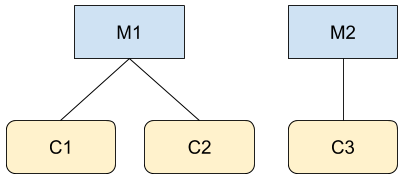Anda dapat mencantumkan pelanggan yang dapat diakses dengan metode
ListAccessibleCustomers
di CustomerService. Namun, Anda perlu
memahami pelanggan mana yang ditampilkan dalam jenis permintaan ini.
Mencantumkan pelanggan yang dapat diakses adalah salah satu dari beberapa permintaan di Google Ads API yang tidak mengharuskan Anda menentukan ID pelanggan dalam permintaan, dan permintaan akan mengabaikan login-customer-id yang diberikan.
Daftar pelanggan yang dihasilkan akan didasarkan pada kredensial OAuth Anda. Permintaan
tersebut akan menampilkan daftar semua akun yang dapat ditindaklanjuti
secara langsung dengan kredensial Anda saat ini. Daftar ini tidak selalu mencakup semua akun dalam hierarki akun. Lebih tepatnya, daftar ini hanya akan menyertakan akun yang mana pengguna terautentikasi Anda telah ditambahkan dengan hak admin atau hak lainnya di akun tersebut.

Bayangkan Anda adalah pengguna A yang juga seorang admin untuk M1 dan C3 dalam dua
hierarki yang ditampilkan dalam gambar. Jika Anda melakukan panggilan ke Google Ads API, misalnya ke GoogleAdsService, Anda dapat mengakses informasi untuk akun M1, C1, C2, dan C3. Namun, panggilan ke
CustomerService.ListAccessibleCustomers
hanya akan menampilkan M1 dan C3 karena hanya kedua akun tersebut yang dapat diakses
langsung oleh pengguna A.
Berikut adalah contoh kode yang menggambarkan penggunaan
metode
CustomerService.ListAccessibleCustomers:
Java
private void runExample(GoogleAdsClient client) { // Optional: Change credentials to use a different refresh token, to retrieve customers // available for a specific user. // // UserCredentials credentials = // UserCredentials.newBuilder() // .setClientId("INSERT_OAUTH_CLIENT_ID") // .setClientSecret("INSERT_OAUTH_CLIENT_SECRET") // .setRefreshToken("INSERT_REFRESH_TOKEN") // .build(); // // client = client.toBuilder().setCredentials(credentials).build(); try (CustomerServiceClient customerService = client.getLatestVersion().createCustomerServiceClient()) { ListAccessibleCustomersResponse response = customerService.listAccessibleCustomers( ListAccessibleCustomersRequest.newBuilder().build()); System.out.printf("Total results: %d%n", response.getResourceNamesCount()); for (String customerResourceName : response.getResourceNamesList()) { System.out.printf("Customer resource name: %s%n", customerResourceName); } } }
C#
public void Run(GoogleAdsClient client) { // Get the CustomerService. CustomerServiceClient customerService = client.GetService(Services.V22.CustomerService); try { // Retrieve the list of customer resources. string[] customerResourceNames = customerService.ListAccessibleCustomers(); // Display the result. foreach (string customerResourceName in customerResourceNames) { Console.WriteLine( $"Found customer with resource name = '{customerResourceName}'."); } } catch (GoogleAdsException e) { Console.WriteLine("Failure:"); Console.WriteLine($"Message: {e.Message}"); Console.WriteLine($"Failure: {e.Failure}"); Console.WriteLine($"Request ID: {e.RequestId}"); throw; } }
PHP
public static function runExample(GoogleAdsClient $googleAdsClient) { $customerServiceClient = $googleAdsClient->getCustomerServiceClient(); // Issues a request for listing all accessible customers. $accessibleCustomers = $customerServiceClient->listAccessibleCustomers(new ListAccessibleCustomersRequest()); print 'Total results: ' . count($accessibleCustomers->getResourceNames()) . PHP_EOL; // Iterates over all accessible customers' resource names and prints them. foreach ($accessibleCustomers->getResourceNames() as $resourceName) { /** @var string $resourceName */ printf("Customer resource name: '%s'%s", $resourceName, PHP_EOL); } }
Python
def main(client: GoogleAdsClient) -> None: customer_service: CustomerServiceClient = client.get_service( "CustomerService" ) accessible_customers: ListAccessibleCustomersResponse = ( customer_service.list_accessible_customers() ) result_total: int = len(accessible_customers.resource_names) print(f"Total results: {result_total}") resource_names: List[str] = accessible_customers.resource_names for resource_name in resource_names: # resource_name is implicitly str print(f'Customer resource name: "{resource_name}"')
Ruby
def list_accessible_customers() # GoogleAdsClient will read a config file from # ENV['HOME']/google_ads_config.rb when called without parameters client = Google::Ads::GoogleAds::GoogleAdsClient.new accessible_customers = client.service.customer.list_accessible_customers().resource_names accessible_customers.each do |resource_name| puts "Customer resource name: #{resource_name}" end end
Perl
sub list_accessible_customers { my ($api_client) = @_; my $list_accessible_customers_response = $api_client->CustomerService()->list_accessible_customers(); printf "Total results: %d.\n", scalar @{$list_accessible_customers_response->{resourceNames}}; foreach my $resource_name (@{$list_accessible_customers_response->{resourceNames}}) { printf "Customer resource name: '%s'.\n", $resource_name; } return 1; }
curl
# Returns the resource names of customers directly accessible by the user # authenticating the call. # # Variables: # API_VERSION, # DEVELOPER_TOKEN, # OAUTH2_ACCESS_TOKEN: # See https://developers.google.com/google-ads/api/rest/auth#request_headers # for details. # curl -f --request GET \ "https://googleads.googleapis.com/v${API_VERSION}/customers:listAccessibleCustomers" \ --header "Content-Type: application/json" \ --header "developer-token: ${DEVELOPER_TOKEN}" \ --header "Authorization: Bearer ${OAUTH2_ACCESS_TOKEN}" \
Mencantumkan akun yang dibatalkan
Google Ads API tidak menyediakan cara langsung untuk mencantumkan akun yang dibatalkan dalam akun Pengelola. Namun, Anda dapat menggunakan solusi sementara berikut untuk mengambil daftar ini.
Ambil daftar link
ACTIVEmenggunakan resourcecustomer_client_linkdan buat daftar pelanggan menggunakan kolomcustomer_client_link.client_customer.SELECT customer_client_link.client_customer, customer_client_link.status FROM customer_client_link WHERE customer_client_link.status = ACTIVEAmbil daftar akun
ENABLEDmenggunakan resourcecustomer_client.SELECT customer_client.id, customer_client.descriptive_name FROM customer_clientPerbedaan antara kedua daftar tersebut akan memberi Anda daftar akun yang dibatalkan.

